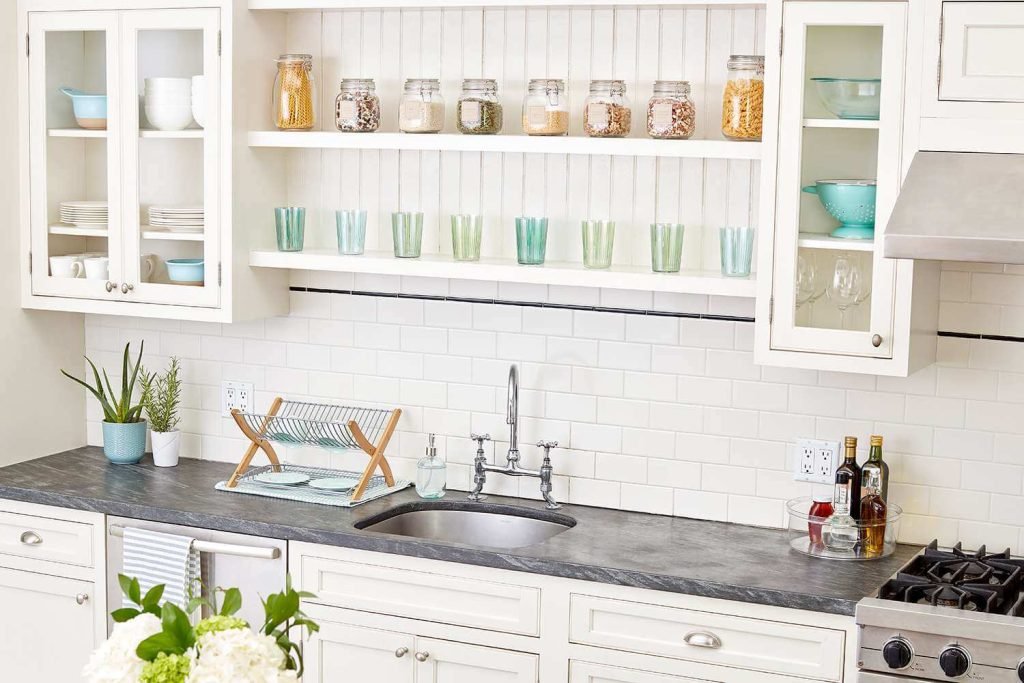
Organizing kitchen cabinets can be a daunting task, especially if you have a lot of items to store in a limited amount of space. However, having a well-organized kitchen not only makes cooking and meal preparation more efficient, but it can also create a visually appealing and clutter-free environment.
The first step to organizing your kitchen cabinets is to declutter and get rid of any items that are expired, broken, or no longer used. This will free up space and make it easier to organize the items that you actually use.
Next, consider how you use your kitchen and prioritize items accordingly. Keep frequently used items within easy reach, while less frequently used items can be stored in higher or lower cabinets. Utilize shelf risers, drawer dividers, and other organizing tools to maximize space and keep items grouped together.
Finally, maintain your organized cabinets by regularly decluttering and rearranging items as needed. With a little effort and planning, you can create a functional and visually appealing kitchen that makes meal preparation a breeze.
How To Organize Kitchen Cabinets?
Here are some steps to help you organize your kitchen cabinets:
1. Declutter
Decluttering is an essential step to organizing your kitchen cabinets. Here are some details on how to declutter effectively:
- Take everything out: Empty your cabinets and drawers completely. This will allow you to see everything you have and make it easier to sort through.
- Sort items into categories: Divide your items into categories such as appliances, dishes, utensils, etc. This will help you see how much of each item you have and make it easier to identify items that can be donated or discarded.
- Determine what to keep: Ask yourself if you use the item frequently or if it has sentimental value. If the answer is no, consider donating or discarding the item.
- Get rid of expired items: Check expiration dates on items like spices, canned goods, and baking supplies. Discard any expired items.
- Consider duplicates: If you have multiple of the same item, consider keeping only one or donating the extra.
- Donate or discard: Once you have sorted through everything, donate or discard items that are no longer needed or used.
Decluttering will help create more space in your cabinets and make it easier to organize your items effectively.
2. Group Similar Items
Grouping similar items is an important step to organizing your kitchen cabinets. Here are some details on how to group similar items effectively:
- Sort items into categories: Divide your items into categories such as baking supplies, canned goods, spices, utensils, etc. This will make it easier to see how much of each item you have and help you determine the best storage location.
- Keep like items together: Store items in the same category together. For example, keep all your baking supplies like flour, sugar, and baking powder together.
- Consider frequency of use: Place frequently used items at the front of the cabinet and less frequently used items towards the back. This will make it easier to access items that are used frequently.
- Use storage containers: Use clear storage containers to group small items together like spices, tea bags, or snacks. This will make it easier to see what you have and make it easier to access.
- Utilize shelf dividers: Use shelf dividers to separate plates, pans, or cutting boards. This will create more space and make it easier to access items.
Grouping similar items together will make it easier to find what you need when cooking, and it will also make it easier to maintain the organization of your kitchen cabinets.
3. Consider Your Storage Options
Considering your storage options is a crucial step to organizing your kitchen cabinets. Here are some details on how to choose the best storage options for your needs:
- Measure your space: Measure your cabinets and drawers to determine what size storage containers and organizers you need.
- Use cabinet shelves: Add extra shelves to your cabinets to create more space. You can purchase adjustable shelves or use stacking shelves to maximize space.
- Install cabinet organizers: Install organizers like pull-out drawers or lazy susans to maximize space and make it easier to access items.
- Use drawer dividers: Use drawer dividers to separate items like utensils or baking sheets. This will create more space and make it easier to find what you need.
- Utilize vertical space: Install hooks or racks to store items like mugs or pots and pans. This will free up space in your cabinets and make it easier to access items.
- Use clear storage containers: Use clear containers to store dry goods like pasta, cereal, or snacks. This will make it easier to see what you have and make it easier to access.
Choosing the right storage options for your needs will help create a more efficient and organized kitchen. It will also make it easier to find what you need when cooking and cleaning up.
4. Use Height to Your Advantage
Using height to your advantage is a great way to maximize space in your kitchen cabinets. Here are some details on how to use height effectively:
- Store tall items vertically: Store items like baking sheets, cutting boards, and trays vertically in your cabinets. This will create more space and make it easier to see what you have.
- Use risers: Use risers to create more space in your cabinets. You can use them to store plates, bowls, or canned goods. This will make it easier to access items and create more space.
- Use the top shelf: Use the top shelf of your cabinets to store items that are used less frequently, like seasonal items or extra appliances. This will free up space in lower cabinets for more frequently used items.
- Use under-shelf baskets: Use under-shelf baskets to store small items like snacks or spices. This will create more space and make it easier to access items.
- Install hooks: Install hooks under your cabinets to store items like mugs, cups, or utensils. This will create more space in your cabinets and make it easier to access items.
Using height effectively will help create more space in your kitchen cabinets and make it easier to access items. It will also create a more organized and efficient kitchen.
5. Store Frequently Used Items at Eye-Level
Storing frequently used items at eye-level is a great way to make your kitchen more efficient. Here are some details on how to store frequently used items at eye-level:
- Identify frequently used items: Take a look at the items you use most often in your kitchen, such as plates, bowls, and glasses.
- Place frequently used items at eye-level: Store frequently used items at eye-level in your cabinets. This will make it easier to access them when you need them.
- Keep less frequently used items on higher or lower shelves: Place less frequently used items like seasonal items or extra appliances on the top or bottom shelves.
- Use step-stools or reachers: If you have items stored on higher shelves that you use frequently, consider using a step-stool or reacher to access them more easily.
- Keep heavy items on lower shelves: Store heavy items like pots and pans on lower shelves to avoid lifting heavy items up and down.
- Adjust shelves if necessary: If your shelves are fixed, consider installing adjustable shelves to make it easier to store items at eye-level.
Storing frequently used items at eye-level will create a more efficient and organized kitchen. It will also make it easier to find what you need when cooking or cleaning up.
6. Label Your Containers
Labeling your containers is an important step to keeping your kitchen cabinets organized. Here are some details on how to label your containers effectively:
- Choose the right labels: Choose labels that are easy to read and will stick to your containers. You can use adhesive labels or write directly on the container with a permanent marker.
- Use clear labels: Use clear labels so that you can see the contents of the container. This will make it easier to find what you need and avoid confusion.
- Include important information: Include important information on the label, such as the name of the contents, the expiration date, and the date it was stored.
- Be consistent: Use the same labeling system for all your containers to create consistency and make it easier to find what you need.
- Label the front and back: Label both the front and back of the container so that you can see the contents from any angle.
- Use color-coding: Use color-coding to help you quickly identify different categories of food. For example, use red labels for baking supplies and green labels for snacks.
Labeling your containers will help you quickly identify the contents of your kitchen cabinets. It will also help you keep track of expiration dates and avoid confusion.
7. Maintain Regularly
Maintaining your organized kitchen cabinets on a regular basis is important to keep them organized and efficient. Here are some details on how to maintain your kitchen cabinets:
- Regularly declutter: Set a regular schedule to declutter your cabinets and get rid of any items you no longer need or use.
- Rearrange items as needed: As you use items in your cabinets, rearrange them to maintain an organized system.
- Wipe down cabinets: Regularly wipe down the inside of your cabinets to keep them clean and free of crumbs and spills.
- Check expiration dates: Regularly check expiration dates of items in your cabinets and discard any that are expired.
- Restock as needed: Keep track of items that are running low and restock as needed. This will help you avoid overcrowding your cabinets with too many items.
- Use a system to keep track of what you have: Consider using a pantry inventory system or a list to keep track of what you have in your cabinets. This will help you avoid overbuying and keep your cabinets organized.
Maintaining your organized kitchen cabinets on a regular basis will help you keep them efficient and prevent them from becoming cluttered again. It will also make it easier to find what you need when cooking or cleaning up.
Conclusion
In conclusion, organizing your kitchen cabinets is a great way to make your kitchen more efficient and enjoyable to use. By decluttering, grouping similar items, using storage options effectively, using height and eye-level to your advantage, labeling your containers, and maintaining your cabinets regularly, you can create a more organized and functional kitchen. These tips can save you time and stress when cooking, and make it easier to find what you need in your cabinets. With a little effort and consistency, you can create a system that works for you and your kitchen, and enjoy the benefits of a more organized space.
